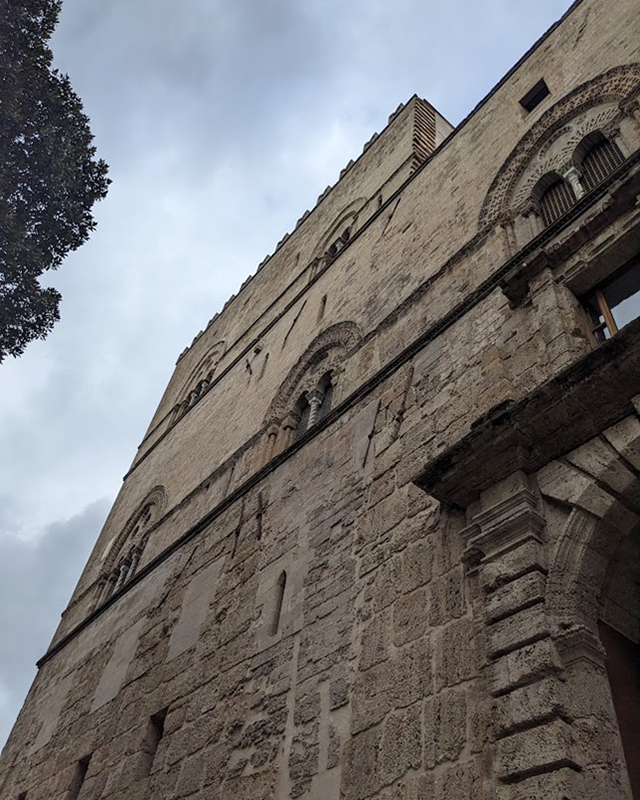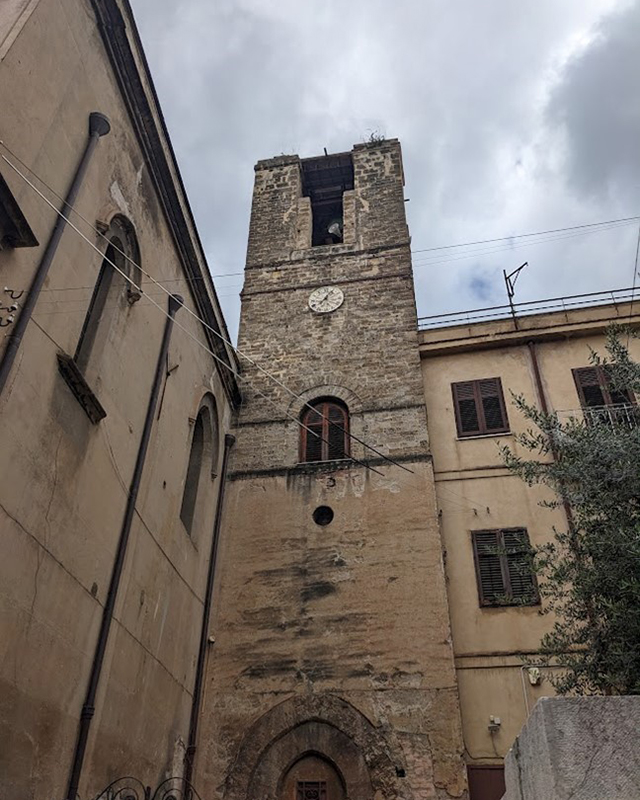Susannah Bain
Traditionally, the landed families that dominated the political landscape of fourteenth-century Sicily have been cast in the mould of the feuding, disruptive baron. At a weak point in the fortunes of the Sicilian monarchy, families such as the Palizzi and Rossi established their own bases of power distinct from the authority of the monarchy and fought with one another, worsening the predicaments of the already war-torn and plague-ridden island. To many nineteenth- and early twentieth-century scholars, the disruption caused by the barons was one aspect of a much longer chain of unfortunate events which disrupted Sicily’s vitality, and paved the way for the economic and political difficulties that continue to define the island in the present day. More recent studies of this period have taken a more nuanced approach to these barons, considering their influence within pan-Mediterranean political networks and how they established and exercised their political authority [i]. A key aspect of the political operation of these middling elites was their engagement with Sicily’s urban centres. Not only did cities provide revenue, but the nobles used them as a stage for displaying their political power, embedding themselves in existing political structures, and to present themselves (with mixed success) as upstanding and worthy leaders.
One of the foremost baronial families in Sicily were the Chiaramonte (or Chiaromonte). The Chiaramonte claimed a presence on the island since the Norman conquest, but appear frequently in historical records from the time of Holy Roman Emperor Frederick II (d. 1250). Like many of Sicily’s most prominent noble families, the domains and responsibilities of the Chiaramonte grew rapidly in the period of political flux that followed the Sicilian Vespers rebellion (1282). During the war between the Aragonese and Angevin royal dynasties following the Aragonese takeover of Sicily, Giovanni I Chiaramonte became admiral of the Sicilian fleet. He was, however, exiled because of a feud with the Ventimiglia dynasty, spending time at the courts of both the Holy Roman emperor Louis IV of Bavaria (d. 1347) and his rival, Robert of Anjou (d. 1343) in Naples. After returning to Sicily, the Chiaramonte established their position as the foremost noble dynasty on the island – in terms of territories and titles. Giovanni II was appointed royal maggiordomo and senescalco. The Chiaramonte held territories in rural areas and cities across Sicily, constructing palaces and castelli in Mazara, Agrigento, Favara, Enno, Siracusa, Palma, Montechiaro, Chiaramonte Gulfi, Racalmuto, Vicari, Misilmeri and other locations. Within this large assemblage of lands, the base of their operations was Palermo. The offices given to the Chiaramonte by the royals often centred there. For example, Giovanni II was capitano and giustiziere of the city – with extensive rights over Palermo’s judicial system and government. His descendants took up equivalent roles in his stead. Within these appointments, they worked in parallel with the city’s universitas, or representative urban council. As a consequence of, to support their continued holding of, these profitable and powerful offices, Palermo became a key stage on which the family tried to project its authority during its ascendency in the fourteenth century.
Like Sicilian baronial families rooted in other cities, such as the Rossi family in Messina, the Chiaramonte constructed and patronised buildings across Palermo. Most famous among these was their palace: the Steri. On 2nd February 1306, Giovanni purchased a patch of land in the Kalsa neighbourhood of Palermo. In the deed, the admiral pledged to ‘reclaim and improve’ (bonificare et meliorare)the area [ii]. The choice of the Chiaramonte to build here was not merely the result of availability. Instead, it spoke to historic and contemporary developments in the urban topography. The Kalsa (or al-Khāliṣa) was the site of the Islamic court in Palermo in the early middle ages, but had been neglected since the Norman conquest. The acquisition of a plot in the quarter by the Chiaramonte coincided with broader rejuvenation of the area, as the Kalsa became an increasingly popular place of residence for Pisan and Florentine bankers and merchants operating in Palermo. They lived along the Ruga di Pisa, near the church of San Francesco – which was patronised by the Chiaramonte. In this case, the construction efforts of the Chiaramonte were an attempt to be perceived as part of the renewal of the historic Kalsa quarter, and to appeal to the politically and economically well-connected merchants of Tuscany residing nearby.

The Steri palace formed part of a much larger network of sites owned and patronised by the Chiaramonte. These churches and sites across the city bore dedications to and, often, the insignia of, their patrons. In Palermo and across Sicily, the family perpetuated a visual style known as Chiaramontan-Gothic. This architectural language was distinct to the dynasty, drawing on central medieval Gothic elements which may have been an attempt to associate themselves with the historic and prestigious Norman rulers of the island. In this case, the sponsorship of construction not only gave the Chiaramonte a way of expressing their wealth and associating themselves with religious and civic institutions in Palermo, but of perpetuating a visual identity across the island which propagated their political authority.
Several of these sites patronised by the Chiaramonte were not just places of worship, but significant in the ceremonial and organisation of Palermitan civic politics. Between 1302 and 1313, the family constructed a new tower for the church of San Antonio, near the northern walls of the city and the gate of Patitelli (the Bab al-Bahr). Above the doors to the tower, they engraved their family crest, alongside those of the Palermitan universitas and the kings of Aragon. Strategically placed near a major site of movement in and out of the city, this symbolism drew together the prominence of the Chiaramonte with the other leading political forces in Sicily and Palermo: the main urban representative council and the royal dynasty. San Antonio had an important role in the formal political life of the city. A record from 1354 notes that a judicial court was held in front of San Antonio, convened with the church’s bell in the tower (in atro ecclesiae Sancti Antonii de Cassaro Panormi ad sonam campanae more solito congregati) [iii]. Such a public role appears to have continued later into the century. In 1375, a new, large bell was installed in the tower to call the citizens for Palermo to public council, as well as to announce meetings of the city’s representatives in the island-wide parliament. The engagement of the Chiaramonte with San Antonio seems, therefore, to be an attempt by members of the family to build themselves quite literally into civic political life and its institutions.

Beyond contributing to the built environment of Palermo, the Chiaramonte were involved in the provision of food for the city’s population. This likely reflected their perceived responsibilities as leading political authorities within urban politics, and by abiding to them the family could present themselves as legitimately holding these roles. The period of the Chiaramonte’s dominance of Palermo was one of frequent famine, and as a reflection of this dearth the dynasty appear frequently in surviving records attempting to secure a supply of wheat for the urban population. For example, a document from July 1349 records Manfred Chiaramonte working with the universitas of the city of Palermo. Manfredi orders that no citizen of Palermo or inhabitant of Termini (a major coastal hub for the trade of grain and other foodstuffs to the east of Palermo, also under Chiaramonte’s remit) extract wheat or transport it to anywhere but Palermo for consumption there [iv]. Here, the baron is shown as cooperating with the urban government in organising available supplies to feed the city’s hungry population.
That the ability of the Chiaramonte to meet the common needs of Palermo’s population was significant in justifying their power is visible in that, at times of rebellion against the dynasty, advice and correspondence with other actors involved in urban government focuses on the fulfilment of this duty. A letter survives from 1351, composed a few months before a major insurrection against the Chiaramonte. In it, Lamberto Riso, mayor (sindicatu) of Palermo, asks Federico Chiaramonte to consider ‘the strict necessity faced by the population (universitati)of Palermo for wheat’ and urging him to sell supplies which were stored in warehouses (caricatoi) in Agrigento (southern Sicily), which were also under the Chiaramonte’s remit [v]. This call seems prompted by Federico’s failure to fulfill his duty, keeping provisions in his own warehouses, presumably for later profit. In this case, it appears that the family had to strike a balance between fostering their own wealth, and meeting the needs of the population more generally. The year before had also seen a rebellion in Palermo against Chiaramonte’s leadership prompted, in part, by a lack of food in the city.
While less explored, a similar dynamic may have influenced the Chiaramonte’s engagement with urban water supply. The family occasionally attempted to gain control the rivers of Palermo, through buying the rights to use channels within and outside of the city, and to extract water from them. Their influence is attested to in a record from late April 1329, for example, which documents Filippo di Tarsia acting on behalf of the family to sell a vicenda (a small measure)of water from the Gabriele: a river which descends into Palermo from the Caputo mountains to the south-west of the city [vi]. The desire of the Chiaramonte to control the flow of water was likely primarily informed by wish to supply their properties across and just outside of Palermo. These included mills, as well as gardens and small farms (orti). At the same time, it would have provided a more informal social and economic influence, positioning them as mediators of the resource for a population in constant need of water for urban domestic and commercial use and peri-urban vineyards, olive groves and sugar plantations. If used generously, control of parts of urban water supply would have allowed the Chiaramonte to appear as provisioning for the needs of the city as a whole.
In 1392, heirs to the Aragonese throne landed in Sicily to reclaim their royal domain. After a siege of Palermo by Aragonese troops, Andrea Chiaramonte surrendered. He and his kin were tried for treachery by the king, found guilty, and decapitated in the square in front of their residence, the Steri palace [vii]. In this case, the city of Palermo was not only a key locale within which the Chiaramonte established its political authority, but the stage for its fall.
Scholars of political culture across Afro-Eurasia are used to considering the relationship between royal or imperial authorities and urban centres, but investigating how barons operated with and within cities can also help us understand how these landed elites developed, exercised and projected political power. In the case of the Sicilian barons, the economy, society and space of the city offered opportunities for revenue and for presenting a case for their legitimacy as political leaders – and a site for this to be challenged and, eventually, overturned.
Footnotes
[i] For example, L. Sciascia, Le donne e i cavalier, gli affanni e gli agi: famiglia e potere in Sicilia tra XII e XIV secolo (Messina, 1993).
[ii] The document is reproduced in G. Spatrisano, Lo Steri di Palermo e l’architettura siciliana del Trecento (Palermo, 1992), Appendix, 277-278.
[iii] Spatrisano, Lo Steri di Palermo, 162.
[iv] S. Tramontana, Michele da Piazza e il potere baronale in Sicilia (Messina, 1963), p. 265.
[v] S. Tramontana, Michele da Piazza e il potere baronale in Sicilia (Messina, 1963), p. 265.
[vi] Acta curie felicis urbis panormi, vol. 6, Registri di lettere (1321 – 22 e 1335 – 36), ed. L. Sciascia (Palermo: 1987), XXVII for details and references.
[vii] L. Sciascia, ‘Palermo as a Stage for, and a Mirror of, Political Developments from the 12th to the 15th Century’, in A Companion to Medieval Palermo, ed. A. Nef (Leiden, 2013), 317.

